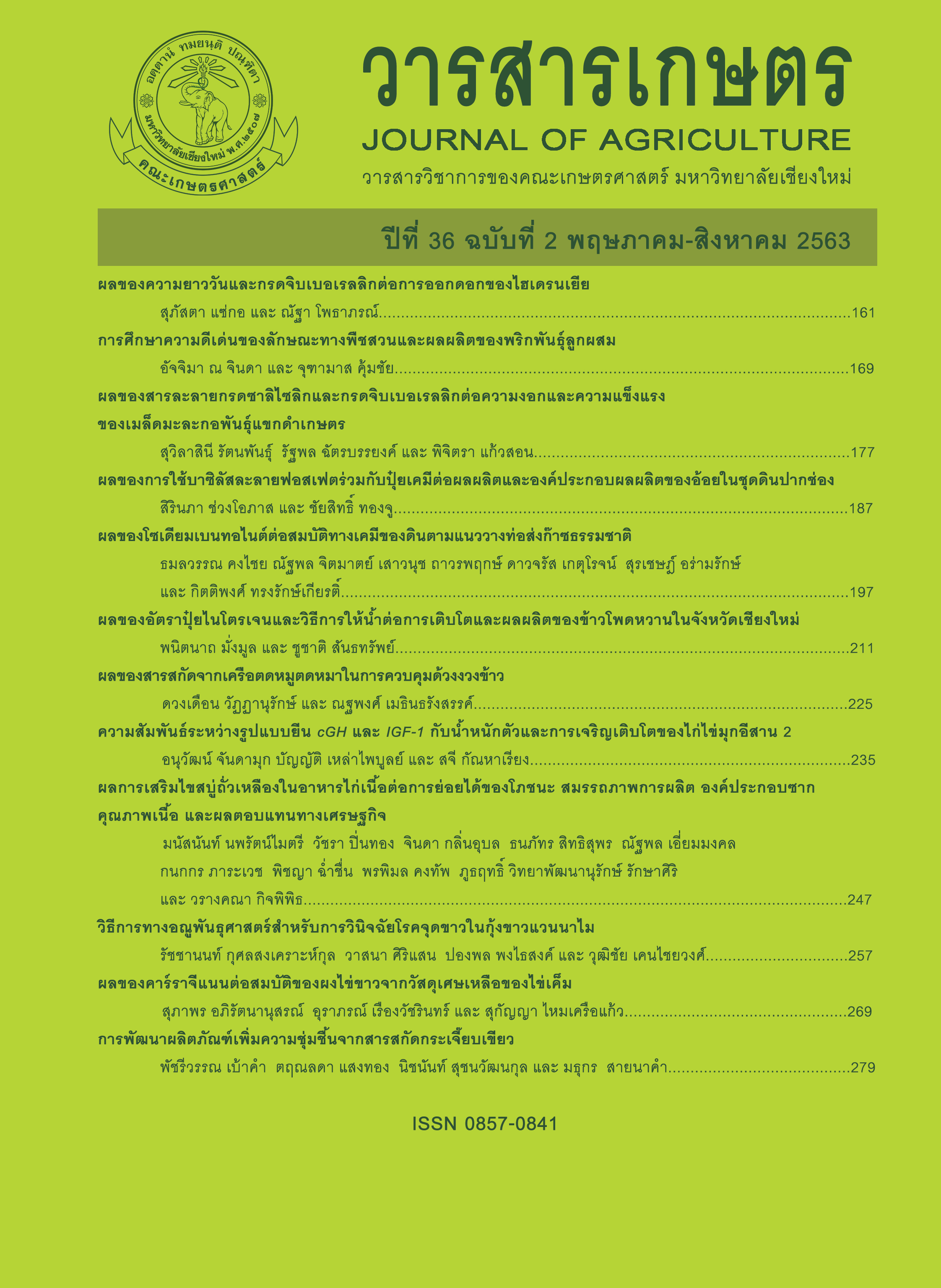ผลของสารละลายกรดซาลิไซลิกต่อความงอกและความแข็งแรงของเมล็ดมะละกอพันธุ์แขกดำเกษตร
Main Article Content
บทคัดย่อ
ศึกษาวิธีการกระตุ้นความงอกของเมล็ดมะละกอพันธุ์แขกดำเกษตรเพื่อให้เมล็ดมีความงอกและความแข็งแรงสูง โดยแช่เมล็ดในน้ำ reverse osmosis (RO) สารละลายกรดจิบเบอเรลลิก (GA3) และสารละลายกรดซาลิไซลิก (SA) ที่ความเข้มข้นต่าง ๆ เป็นเวลา 16 ชั่วโมง วางแผนการทดลองแบบสุ่มสมบูรณ์ มี 7 กรรมวิธี ได้แก่ น้ำ RO สารละลาย GA3 ความเข้มข้น 500 มิลลิกรัมต่อลิตร และสารละลาย SA ความเข้มข้น 50, 100, 250 และ 500 มิลลิกรัมต่อลิตร เปรียบเทียบกับเมล็ดที่ไม่ได้กระตุ้นความงอก (ชุดควบคุม) พบว่าการแช่เมล็ดในสารละลาย GA3 ความเข้มข้น 500 มิลลิกรัมต่อลิตร ไม่มีผลต่อความงอกเมื่อเปรียบเทียบกับเมล็ดในชุดควบคุม แต่กรรมวิธีนี้มีผลทำให้เวลาเฉลี่ยในการงอกเร็วกว่าเมล็ดในชุดควบคุม (ประมาณ 1 วัน) นอกจากนี้การแช่เมล็ดในสารละลาย SA ทุกความเข้มข้นไม่มีผลต่อความงอกเมื่อเปรียบเทียบกับเมล็ดในชุดควบคุม
Article Details
เอกสารอ้างอิง
Aekaraj, C. 2003. Seed Technology. Tarnkasettakum Publishing, Nonthaburi. 197 p. (in Thai)
Agricultural Regulatory Office. 2018. Quantity and value of controlled seed exports for commercial purposes. (Online). Available: http://www.doa.go.th/ard/wp-content/uploads/2019/03/PS1PL-Ex61.pdf (July 5, 2019). (in Thai)
Alonso-Esquivel, M., Y. Ortiz-Lopez, R. Ramos-Ramirez, H. Oliva-Diaz and M. Capote-del Sol. 2011. Dormancy of papaya seeds cv. Maradol Roja during storage. Agronomia Mesoamericana 22(2): 351-357.
Babpraserth, C. 2008. Papaya. (Online). Available: http://www.rakbankerd.com/agriculture/page.php?id=514&s=tblplant&w=%E0 %B8%95%E0%B9%89%E0%B8%99%E0%B8%81%E0%B8%B0%E0%B9%80%E0%B8%97%E0%B8%A2 (July 4, 2019). (in Thai)
Bewley, J.D. and M. Black. 1978. Physiology and Biochemistry of Seeds in Relation to Germination: Volume 1. Development, Germination and Growth. Springer-Verlag, Berlin. 306 p.
Bradford, K.J. 1990. A water relations analysis of seed germination rates. Plant Physiology 94: 840-849.
Carrillo-Castañeda, G.M., F. Bautista-Calles and A. Villegas-Monter. 2013. Postharvest seed treatments to improve the papaya seed germination and seedlings development. Tropical and Subtropical Agroecosystems 16(1): 133-141.
Chanprasert, W. 2010. Seed Physiology. Extension and Training Office Press, Kasetsart University, Bangkok. 163 p. (in Thai)
Desai, B.B., P.M. Kotecha and D.K. Salunkhe. 1997. Seeds Handbook: Biology, Production, Processing and Storage. Marcel Dekker, Inc., New York. 627 p.
Desai, A., B. Panchal, A. Trivedi and D. Prajapati. 2017. Studies on seed germination and seedling growth of papaya (Carica papaya L.) cv. Madhubindu as influenced by media, GA3 and cow urine under net house condition. Journal of Pharmacognosy and Phytochemistry 6(4): 1448-1451.
Duangpatra, J. 1986. Seed Technology. 2nd ed. Agriculture Book Group, Bangkok. 210 p. (in Thai)
Ellis, R.H. and E.H. Roberts. 1980. Improved equations for the prediction of seed longevity. Annals of Botany 45(1): 13-30.
Furutani, S.C. 1987. Influence of temperature, KNO3, GA3 and seed drying on emergence of papaya seedling. Scientia Horticulturae 32: 67-72.
Hayat, Q., S. Hayat, M. Irfan and A. Ahmad. 2010. Effect of exogenous salicylic acid under changing environment: a review. Environmental and Experimental Botany 68(1): 14-25.
ISTA. 2018. International Rules for Seed Testing. International Seed Testing Association, Basserdorf, Switzerland. 298 p.
Kasetsart University Research and Development Institute. 2019. Papaya cv. Khaek Dam Kaset. (Online). Available: https://www3.rdi.ku.ac.th/wp-contents/uploads/2018/08/มะละกอ-แขกดำเกษตร.pdf (July 23, 2019). (in Thai)
Khlaykhum, A., D. Thawornchareon and K. Thaipong. 2018. Effect of prehydration on germination of papaya seed. Agricultural Science Journal 49: 1(Suppl.): 399-401.
(in Thai)
Pornpatcharareungkul, P. 2014. Effect of salicylic acid on germination of ‘Khaek Dam’ papaya (Carica papaya L.) seed. B.S. Special Problem. Faculty of Agriculture, Kasetsart University, Bangkok. 16 p. (in Thai)
Riley, J.M. 1981. Growing rare fruit from seed. CRFG Yearbook 13: 1-47.
Sansuk, M. 2014. Papaya is Making Rich Money. Nana Publishing, Bangkok. 160 p. (in Thai)
Sukkaew, S. 2016. Effect of seed enhancement by chemical solution on quality of ‘Holland’ papaya (Carica papaya L.) seed. B.S. Special Problem. Faculty of Agriculture, Kasetsart Univeristy, Bangkok. 23 p. (in Thai)
Sukprakarn, S. 2008. Seed Testing for Horticultural Crop. 10th ed. Department of Horticulture, Kasetsart University, Bangkok. 153 p. (in Thai)
Tang, C.S. 1971. Benzyl isothiocyanate of papaya fruit. Phytochemistry 10(1): 117-121.
The Secretariat of the Cabinet. 2013. Announcement of Ministry of Agriculture and Cooperatives on “Standard quality and storage of controlled seed (Volume 2) B.E. 2556”. Royal Thai Government Gazette. 130, Special Chapter 148 Ngor. p. 32-33. Dated 31 October B.E. 2556. (in Thai)
Zanotti, R.F., D.C.F.S. Dias, R.S. Barros, F.M. DaMatta and G.L. Oliveira. 2014. Germination and biochemical changes in ‘Formosa’ papaya seeds treated with plant hormones. Acta Scientiarum, Agronomy 36(4): 435-442.


